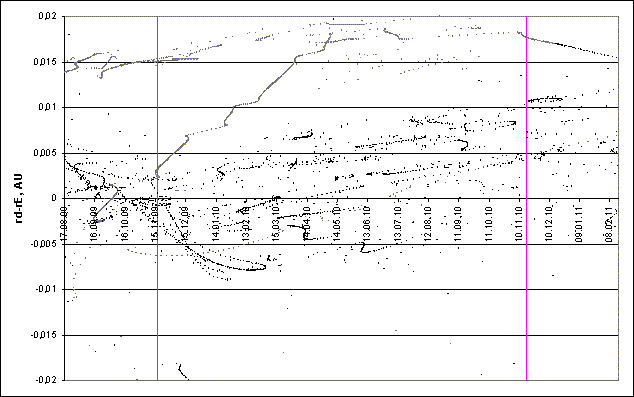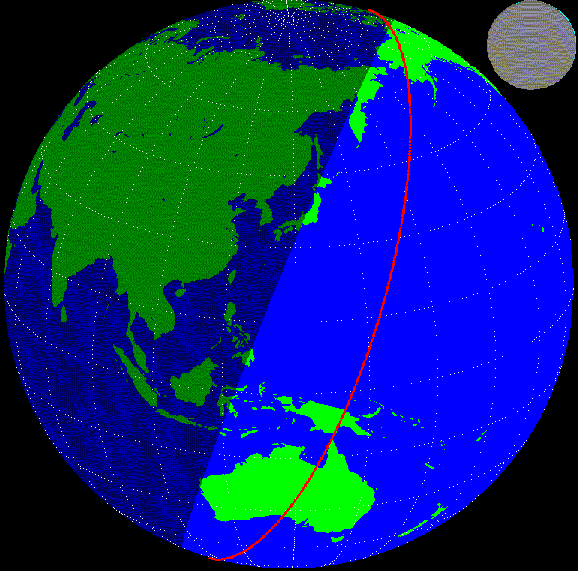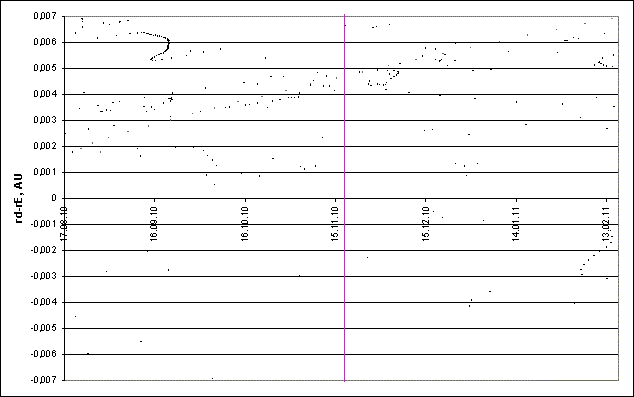Leonids 2009-2010: prediction of activity
to the list of predictions
Introduction
Computation characteristics
We'd like to introduce the results of Leonid meteor stream simulation aimed to the prediction of shower activity in 2009 and 2010. The simulation was made for the trails of latest 30 revolutions, i.e, from the 1001 trail. The Author used the program by S. Shanov and S. Dubrovsky to calculate orbital elements of ejected meteor particles. To estimate expected ZHRs for different encounters the model by E. Lyytinen and T. van Flandern given in their paper [3] was used with some Author's alterations made in order to adopt the model for ejection velocity (Vej) instead of da0 (difference in a-semimajor axis) as well as to correct fn function to consider factual Leonids activity during recent storms and outbursts. The computation considered only gravitational forces. The following parts of trails were computed: the first 5 rev. trails for ejection velocities [-50;100] m/s, 6-10 rev. trails - [-30;50] m/s, 10-20 rev. trails - [-20;30], older than 20 rev. trails - [-10;20] m/s.
Results
Introduction
Computation characteristics
We'd like to introduce the results of Leonid meteor stream simulation aimed to the prediction of shower activity in 2009 and 2010. The simulation was made for the trails of latest 30 revolutions, i.e, from the 1001 trail. The Author used the program by S. Shanov and S. Dubrovsky to calculate orbital elements of ejected meteor particles. To estimate expected ZHRs for different encounters the model by E. Lyytinen and T. van Flandern given in their paper [3] was used with some Author's alterations made in order to adopt the model for ejection velocity (Vej) instead of da0 (difference in a-semimajor axis) as well as to correct fn function to consider factual Leonids activity during recent storms and outbursts. The computation considered only gravitational forces. The following parts of trails were computed: the first 5 rev. trails for ejection velocities [-50;100] m/s, 6-10 rev. trails - [-30;50] m/s, 10-20 rev. trails - [-20;30], older than 20 rev. trails - [-10;20] m/s.
Results

Fig. 1. Space-temporal projection of Leonids trails parts onto their minimal distance passages diring the period 17.08.2009-17.02.2011 (correspondence between colours of the particles and their ejection velocities can be seen here).

Fig. 2. Detailed space-temporal projection of Leonids trails parts onto their minimal distance passages diring the period 17.08.2009-17.02.2010 (correspondence between colours of the particles and their ejection velocities can be seen here).
Leonids in 2009

Fig. 3. Assumed profile of overall Leonid activity (blue line) and its background component (red line).

Fig. 4. Assumed profile of overall Leonid activity (blue line) besides main peak and its background component (red line).
In 2009, besides traditional maximum, which is expected to be strong (with ZHR of 20-25), the Leonids should give a number of outbursts. The first of them is a small peak from 1767 trail. One of dense fragments of this trail will give three encounters with the Earth. Their parameters: 1) rD-rE=0.00223 а.е., Vej=42.92 м/с, fM(fMD)=0.124; 2) rD-rE=0.00247 а.е., Vej=43.04 м/с, fM(fMD)=-0.731; 2) rD-rE=0.00307 а.е., Vej=43.38 м/с, fM(fMD)=1.356. Together with background activity it is expected that these encounters increase the ZHR to 15-20, computed time of maximum is 16 November 13:30 UT. We expect, that 1767 trail meteors will be quite faint, in radiorange some higher activity is possible.
The second, also small activity peak will be caused by 1567 trail particles. The parameters are the folowing: rD-rE=-0.00289 а.е., Vej=10.00 м/с, fM(fMD)=0.074. The trail will pass at quite large distance from the Earth, so the increase in activity will be very modest - up to 25-30 meteor with background. Time of closest encounter with the trail is 17 November 6:20 UT, but growing background activity could shift peak time up to 1-2 hours later, or activity show a plato with ZHR of 25-30 starting from ~6 UT on 17 November. Brightness of 1567 trail meteors should be a little higher than average.
Traditional Leonid maximum is expected to be hidden beyond the third, mail Leonids peak in 2009 - from 1466 and 1533 trails. The Earth will have multiple encounters with fragments of these trails, in a whole they should give a wide and intensive activity outburst with ZHR of 170-180. Computed maximum time is 17 November 21:35 UT, but diring a couple of hours around this time a number of submaximas is possible. Theoretical radiant: RA=154.3°, Dec=+22.9°. Ejection velocities of particles encontering the Earth are in the range of 10-13 m/s, this assumes meteor brightness close to the avegare level, maybe slightly above it.
Finally, the last fourth (again small) otuburst is expected from 1201 trail. The parameters are: rD-rE=-0.00019 а.е., Vej=14.82 м/с, fM(fMD)=-0.042. Around 18 November 19:24 UT Leonids activity should increase to 20-25 meteors, average brightness. Considering the age of the trail, reliabity of this peak prediction is notable lower than for three previous peaks.
The second, also small activity peak will be caused by 1567 trail particles. The parameters are the folowing: rD-rE=-0.00289 а.е., Vej=10.00 м/с, fM(fMD)=0.074. The trail will pass at quite large distance from the Earth, so the increase in activity will be very modest - up to 25-30 meteor with background. Time of closest encounter with the trail is 17 November 6:20 UT, but growing background activity could shift peak time up to 1-2 hours later, or activity show a plato with ZHR of 25-30 starting from ~6 UT on 17 November. Brightness of 1567 trail meteors should be a little higher than average.
Traditional Leonid maximum is expected to be hidden beyond the third, mail Leonids peak in 2009 - from 1466 and 1533 trails. The Earth will have multiple encounters with fragments of these trails, in a whole they should give a wide and intensive activity outburst with ZHR of 170-180. Computed maximum time is 17 November 21:35 UT, but diring a couple of hours around this time a number of submaximas is possible. Theoretical radiant: RA=154.3°, Dec=+22.9°. Ejection velocities of particles encontering the Earth are in the range of 10-13 m/s, this assumes meteor brightness close to the avegare level, maybe slightly above it.
Finally, the last fourth (again small) otuburst is expected from 1201 trail. The parameters are: rD-rE=-0.00019 а.е., Vej=14.82 м/с, fM(fMD)=-0.042. Around 18 November 19:24 UT Leonids activity should increase to 20-25 meteors, average brightness. Considering the age of the trail, reliabity of this peak prediction is notable lower than for three previous peaks.

Fig. 5. The Earth as seen from coming Leonid meteors (Radiant: RA=154°, Dec=+23°)during the peak from 1466 and 1533 trails at 21:35 UT 17 November. Red line shows the border of hemisphere where the Moon is above horizon (it is shown with in the corner of the Fig. 5 according to its phase).
The Fig. 5 shows the map with regions where this peak from 1466 and 1533 trails would be visible if occured at given time. The most favorable conditions for visual observations will be almost whole asian part of Eurasia, starting from appr. the Aral sea longitude and farther to the east. The exception would be Kamchatsk peninsula and adjasent lands, territories close to the Sea of Okhotsk coast and further to the south till Korean peninsula, at the time of maximum the sky will be already too light to observe there, but the rising branch of the peak should be visible. Good conditions will be in the western part of Indonesian archipelago. Radioobservations are possible on all of the named lands as well as in Japan, eastern part of Indonesia and in Australia. Observers to the west from the Aral sea should be able to watch decreasng branch of the peak, the farther to the west, the less intensive. The new Moon will create no trouble for observations.
Leonids in 2010 (overview)

As shown on the Figs. 1 and 6, in 2010 Leonid trail go away from the Earth orbit, so there are no any signiicant encounters. We expect only traditional Leonids maximum in 2010, which is though should be stronger than average - with ZHR of ~20 meteors.
References
1. "Comet's dust 2.0" program by S. Shanov and S. Dubrovsky. [Used for orbital computations.]
2. Information from Gary W. Kronk's page http://www.maa.agleia.de
3. Lyytinen E, van Flandern T. "Predicting the strength of Leonid outbursts", 2000, Icarus, P. 158-160.
4. Jenniskens P. Meteor showers and their parent comets, 2006, 780 p.
Leonids in 2010 (overview)

Fig. 6. Detailed space-temporal projection of Leonids trails parts onto their minimal distance passages diring the period 17.08.2010-17.02.2011 (correspondence between colours of the particles and their ejection velocities can be seen here).
As shown on the Figs. 1 and 6, in 2010 Leonid trail go away from the Earth orbit, so there are no any signiicant encounters. We expect only traditional Leonids maximum in 2010, which is though should be stronger than average - with ZHR of ~20 meteors.
References
1. "Comet's dust 2.0" program by S. Shanov and S. Dubrovsky. [Used for orbital computations.]
2. Information from Gary W. Kronk's page http://www.maa.agleia.de
3. Lyytinen E, van Flandern T. "Predicting the strength of Leonid outbursts", 2000, Icarus, P. 158-160.
4. Jenniskens P. Meteor showers and their parent comets, 2006, 780 p.